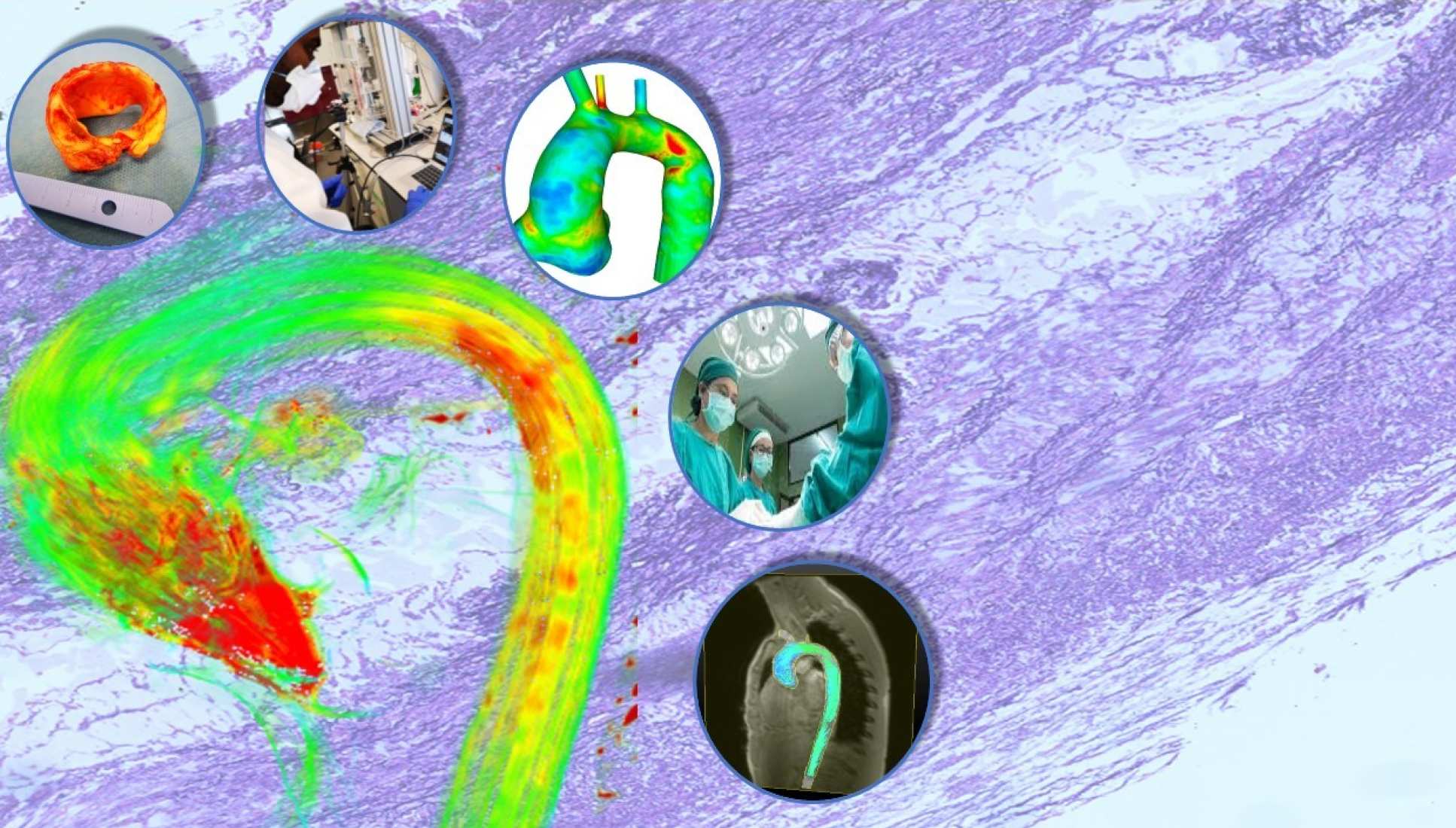
Contact
Professor Thanos Athanasiou
t.athanasiou@imperial.ac.uk
Dr Yousuf Salmasi
y.salmasi@imperial.ac.uk
What we do
The vision of our research group is to improve the diagnostic and treatment process of patients with thoracic aortic aneurysms at risk of a life-threatening type A aortic dissection. Our research brings together advanced imaging technology with tissue biomechanics, genomics, metabolomics and computational modelling.
Why it is important
Guidelines for the management of proximal thoracic aortic aneurysms are limited to size criteria only, and our understanding of which aneurysms are more vulnerable to suffer from acute dissection/rupture is very limited. Most clinical studies tend to be anecdotal, poorly controlled and lack the scientific backing to make ground-breaking conclusions that may change clinical practice.
Biomechanically, acute aortic events occur due to tears occurring spontaneously in the aortic intima/media, leading to formation of a false lumen, which propagates under the aortic pulse pressure to dissect. The failure of the aortic tissue at the dissection entry site occurs as a result of the haemodynamic loads (from blood flow) exceeding its strength
The current gold standard treatment is surgical replacement of the aneurysmal aorta to ward off the life-threatening complications, although it is reserved for at-risk patients owing to the significant burden of surgery. Endovascular management of the proximal thoracic aorta also shows promise, although is not yet established.
How it can benefit patients
Our research aims to create patient-specific computational models to predict how enlarged thoracic aortas will behave over time and assess the risk of aortic dissection.
Our work provides vital data that will be applied to clinical decision support software systems utilising patient specific algorithms that can be used in the hospital setting. This will be vital for patients coming through the multi-disciplinary team in predicting acute aortic events and making important decisions regarding treatment and its timing.
Our research
AI-based aortic image prediction
This project is led by Professor O’Regan and his team, funded by the Heart Research UK. The team uses artificial intelligence (AI) technology to analyse CT scans of thoracic aortas and generate 3D images. Not only will this enable more accurate measurement of aneurysms, but it will also allow clinicians to establish which section of the aorta is under the most stress. Additionally, using data from thousands of patients with TAAs, the team hopes that the AI technology will be able to predict which aneurysms are at the greatest risk of dissection or rupture.
Exploring the role of the proteome in aortic disease
Our research aims to analyse the molecular composition of the aorta in various groups of subjects: syndromic disease, sporadic disease, normal controls. Our group analyses the proteoglycan composition of the aortic wall and the associated plasma circulating levels of these molecules. This cross-collaborative research is led by Dr Salvatore Santamaria (BHF Fellow).
Aortic tissue banking
As part of our commitment to investigating aortic wall phenotypes, and linking structure to function, we collect and store aortic samples obtained from surgical procedures. This allows us to categorise aortopathy and identify proteomic signatures of various aortic phenotypes, in addition to the measurement of material propteries (tensile strength, microstructrual features).
Connections
Our research group actively recruits patients the following London Cardiac centres:
Our research group actively engages with patients who suffer from thoracic aortopathy as well as family members. We are happy to answer any questions or provide any useful material regarding your therapy or the research we conduct.
We also strongly recommend the following patient engagement groups which provide contemporary useful information on Aortic Aneurysms and Dissection:
Our working group has strong collaborations with the following centres of expertise:
Our researchers
Our researchers
Professor Thanos Athanasiou
/prod01/channel_3/media/migration/faculty-of-medicine/Thanos-Athanasiou--tojpeg_1574350251367_x4.jpg)
Professor Thanos Athanasiou
Professor of Cardiovascular Sciences
Professor James Moore Jr
/prod01/channel_3/media/migration/faculty-of-medicine/James-Moore-Jr--tojpeg_1574350448673_x4.jpg)
Professor James Moore Jr
The Bagrit & RAEng Chair in Medical Device Design
Professor Xiao Yun Xu
/prod01/channel_3/media/migration/faculty-of-medicine/xiao--tojpeg_1574416794859_x4.jpg)
Professor Xiao Yun Xu
Professor Biofluid Mechanics, Department of Chemical Engineering
Professor Christoph Nienaber, Royal Brompton
/prod01/channel_3/media/migration/faculty-of-medicine/Professor-Christoph-Nienaber--tojpeg_1574436915877_x4.jpg)
Professor Christoph Nienaber, Royal Brompton
Consultant cardiologist
Professor John Pepper
/prod01/channel_3/media/migration/faculty-of-medicine/Professor--tojpeg_1574945904155_x4.jpg)
Professor John Pepper
Professor of Cardiothoracic Surgery
Dr Declan O’Regan
/prod01/channel_3/media/images/people-list/Declan-O'Regan.jpeg)
Dr Declan O’Regan
Professor of Cardiovascular AI, London Institute of Medical Sciences
Dr Jan-Lukas Robertus
/prod01/channel_3/media/migration/faculty-of-medicine/Jan--tojpeg_1574417352533_x4.jpg)
Dr Jan-Lukas Robertus
Pathologist, Cardiac Histopathology, Royal Brompton
Dr Deborah Morris-Rosendahl, Royal Brompton
/prod01/channel_3/media/migration/faculty-of-medicine/Dr-Deborah-Morris-Rosendahl--tojpeg_1574417565022_x4.jpg)
Dr Deborah Morris-Rosendahl, Royal Brompton
Clinical Genetics and Genomics
Professor Aung Oo, Barts Heart Centre
/prod01/channel_3/media/migration/faculty-of-medicine/oo--tojpeg_1574417827120_x4.jpg)
Professor Aung Oo, Barts Heart Centre
Surgeon - Cardiothoracic
Dr Salvatore Santamaria
/prod01/channel_3/media/images/people-list/Dr-Salvatore-Santamaria.jpeg)
Dr Salvatore Santamaria
BHF fellow, aortic wall proteomics
Dr M Yousuf Salmasi
/prod01/channel_3/media/migration/faculty-of-medicine/Yousuf-Salmasi--tojpeg_1574419222185_x4.jpg)
Dr M Yousuf Salmasi
Clinical Research Fellow
Mr Alessandro Viviano
/prod01/channel_3/media/images/people-list/Mr-Alessandro-Viviano.png)
Mr Alessandro Viviano
Consultant cardiac and aortovascular surgeon
Mr Emad Al-Jaaly
/prod01/channel_3/media/images/people-list/Mr-Emad-Al-Jaaly.jpg)
Mr Emad Al-Jaaly
Consultant cardiac and aortovascular surgeon
Mr Richard Gibbs
/prod01/channel_3/media/migration/faculty-of-medicine/richardgibbs_1624441607252_x4.jpg)
Mr Richard Gibbs
Vascular Surgeon, Honorary Clinical Senior Lecturer
Yu Zhu
/prod01/channel_3/media/images/people-list/people-list-placeholder-400X400px.jpg)
Yu Zhu
Manuel Mayr
/prod01/channel_3/media/images/people-list/Manuel-Mayr-square.jpeg)
Manuel Mayr
Chair of Cardiovascular Proteomics
/prod01/channel_3/media/migration/faculty-of-medicine/Selene-Pirola--tojpeg_1574418285913_x4.jpg)